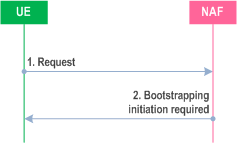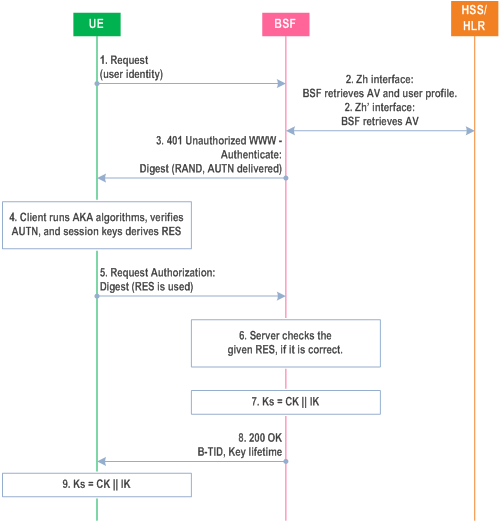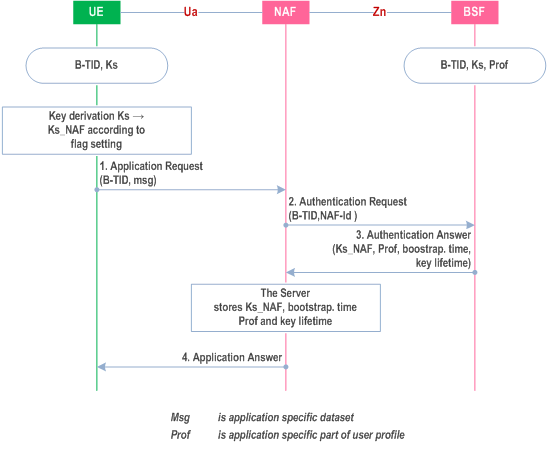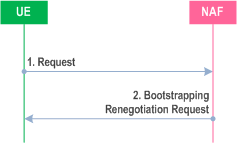Content for TS 33.220 Word version: 18.3.0
4.5 Procedures
4.5.1 Initiation of bootstrapping
4.5.2 Bootstrapping procedures
4.5.3 Procedures using bootstrapped Security Association
4.5.4 Procedure related to service discovery
...
...
4.5 Procedures p. 27
This chapter specifies in detail the format of the bootstrapping procedure that is further utilized by various applications. It contains the AKA authentication procedure with BSF, and the key material generation procedure.
4.5.1 Initiation of bootstrapping p. 27
Before communication between the UE and the NAF can start, the UE and the NAF first have to agree whether to use the GBA. When a UE wants to interact with a NAF, but it does not know if the NAF requires the use of shared keys obtained by means of the GBA, the UE may contact the NAF for further instructions (see Figure 4.2).

- The UE may start communication over reference point Ua with the NAF with or without any GBA-related parameters.
- If the NAF requires the use of shared keys obtained by means of the GBA, but the request from UE does not include GBA-related parameters, the NAF replies with a bootstrapping initiation message. The form of this initiation message may depend on the particular reference point Ua.
4.5.2 Bootstrapping procedures p. 28
When a UE wants to interact with a NAF, and it knows that the bootstrapping procedure is needed, it shall first perform a bootstrapping authentication (see Figure 4.3). Otherwise, the UE shall perform a bootstrapping authentication only when it has received bootstrapping initiation required message or a bootstrapping negotiation indication from the NAF, or when the lifetime of the key in UE has expired (cf. subclause 4.5.3).

A UE shall always include the product token "3gpp-gba-tmpi" in the user agent request-header field when communicating over Ub. A BSF shall always include the product token "3gpp-gba-tmpi" in the server response-header field when communicating over Ub.
Step 1.
If the response included the product token "3gpp-gba-tmpi" in the server response-header field the UE shall compute the TMPI as specified in Annex B.4 and store it together with the IMPI, overwriting a previous TMPI related to this IMPI, if any.
The UE sends an HTTP request towards the BSF. When a TMPI associated with the IMPI in use is available on the UE, the UE includes this TMPI in the "username" parameter, otherwise the UE includes the IMPI.
Step 2.
The BSF recognises from the structure of the "username" parameter (cf. Annex B.4) whether a TMPI or an IMPI was sent. If a TMPI was sent the BSF looks up the corresponding IMPI in its local database. If the BSF does not find an IMPI corresponding to the received TMPI it returns an appropriate error message to the UE. The UE then deletes the TMPI and retries the request using the IMPI.
The BSF retrieves the complete set of GBA user security settings and one Authentication Vector (AV, AV = RAND||AUTN||XRES||CK||IK) over the reference point Zh from the HSS.
In the case that no HSS with Zh reference point is deployed, the BSF retrieves the Authentication Vector over the reference point Zh' from either an HLR or an HSS with Zh' reference point support.
If the BSF implements the timestamp option and has a local copy of the GUSS for the subscriber that has been fetched from the HSS during a previous bootstrapping procedure, and this GUSS includes a timestamp, the BSF may include the GUSS timestamp in the request message. Upon receiving that timestamp, if the HSS implements the timestamp option, the HSS may compare it with the timestamp of the GUSS stored in the HSS. In this case, if and only if the HSS has done the comparison and the timestamps are equal, then the HSS shall send "GUSS TIMESTAMP EQUAL" indication to the BSF. In any other case, the HSS shall send the GUSS (if available) to the BSF. If the BSF receives "GUSS TIMESTAMP EQUAL" indication, it shall keep the local copy of the GUSS. In any other case, the BSF shall delete the local copy of the GUSS, and store the received GUSS (if sent).
Step 3.
Then BSF forwards the RAND and AUTN to the UE in the 401 message (without the CK, IK and XRES). This is to demand the UE to authenticate itself.
Step 4.
The UE checks AUTN to verify that the challenge is from an authorised network; the UE also calculates CK, IK and RES. This will result in session keys IK and CK in both BSF and UE.
Step 5.
The UE sends another HTTP request, containing the Digest AKA response (calculated using RES), to the BSF.
Step 6.
The BSF authenticates the UE by verifying the Digest AKA response.
Step 7.
The BSF generates key material Ks by concatenating CK and IK. The B-TID value shall be also generated in format of NAI by taking the base64 encoded (cf. RFC 4648) RAND value from step 3, and the BSF server name, i.e. base64encode(RAND)@BSF_servers_domain_name.
If the request included the product token "3gpp-gba-tmpi" in the user agent request-header field the BSF shall compute a new TMPI as specified in Annex B.4 and store it together with the IMPI, overwriting a previous TMPI related to this IMPI, if any.
Step 8.
The BSF shall send a 200 OK message, including a B-TID, to the UE to indicate the success of the authentication. In addition, in the 200 OK message, the BSF shall supply the lifetime of the key Ks. The key material Ks is generated in UE by concatenating CK and IK.
Step 9.
Both the UE and the BSF shall use the Ks to derive the key material Ks_NAF during the procedures as specified in clause 4.5.3. Ks_NAF shall be used for securing the reference point Ua.
Ks_NAF is computed as Ks_NAF = KDF (Ks, "gba-me", RAND, IMPI, NAF_Id), where KDF is the key derivation function as specified in Annex B, and the key derivation parameters consist of the user's IMPI, the NAF_Id and RAND. The NAF_Id is constructed as follows: NAF_Id = FQDN of the NAF || Ua security protocol identifier. The Ua security protocol identifier is specified in Annex H. KDF shall be implemented in the ME.
4.5.3 Procedures using bootstrapped Security Association p. 30
Before communication between the UE and the NAF can start, the UE and the NAF first have to agree whether to use shared keys obtained by means of the GBA. If the UE does not know whether to use GBA with this NAF, it uses the Initiation of Bootstrapping procedure described in clause 4.5.1.
Once the UE and the NAF have established that they want to use GBA then every time the UE wants to interact with an NAF the following steps are executed as depicted in Figure 4.4.
Step 1.
Once the run of the protocol used over reference point Ua is completed the purpose of bootstrapping is fulfilled as it enabled UE and NAF to use reference point Ua in a secure way.
UE starts communication over reference point Ua with the NAF:
Step 2.
-
in general, UE and NAF will not yet share the key(s) required to protect the reference point Ua. If they already do (i.e. if a key Ks_NAF for the corresponding key derivation parameter NAF_Id is already available), the UE and the NAF can start to securely communicate right away. If the UE and the NAF do not yet share a key, the UE proceeds as follows:
- if a key Ks for the selected UICC application is available in the UE, the UE derives the key Ks_NAF from Ks, as specified in clause 4.5.2;
- if no key Ks for the selected UICC application is available in the UE, the UE first agrees on a new key Ks with the BSF over the reference point Ub, and then proceeds to derive Ks_NAF If it is not desired by the UE to use the same Ks for the selected UICC application to derive more than one Ks_NAF then the UE should agree on a new key Ks with the BSF over the reference point Ub, and then proceed to derive Ks_NAF.
- if the NAF shares a key with the UE, but the NAF requires an update of that key, e.g. because the key's lifetime has expired or will expire soon, or the key can not meet the NAF local validity condition, it shall send a suitable bootstrapping renegotiation request to the UE, see Figure 4.5. If the key's lifetime has expired the protocol used over reference point Ua shall be terminated. The form of this indication depends on the particular protocol used over reference point Ua. If the UE receives a bootstrapping renegotiation request, it starts a run of the protocol over reference point Ub, as specified in clause 4.5.2, in order to obtain a new key Ks. To allow for consistent key derivation in BSF and UE, both have to use the same FQDN for derivation (see clause 4.5.2). For each protocol used over Ua it shall be specified if only cases (1) and (2) of clause 4.5.2 are allowed for the NAF or if the protocol used over Ua shall transfer also the FQDN used for key derivation by UE to NAF.
- the UE supplies the B-TID to the NAF, in the form as specified in clause 4.5.2, to allow the NAF to retrieve the corresponding keys from the BSF;
- the key management procedures for GBA related keys in the ME (i.e. Ks and Ks_NAF keys) are described in clause 4.4.11.
- when a new Ks is agreed over the reference point Ub and a key Ks_NAF, derived from one NAF_Id, is updated, the other keys Ks_NAF, derived from different values NAF_Id, stored on the UE shall not be affected; According to the procedures defined in clauses 4.5.2 and 4.5.3, in the UE there is at most one Ks_NAF key stored per NAF-Id.
NAF starts communication over reference point Zn with BSF
Step 3.
- The NAF requests key material corresponding to the B-TID supplied by the UE to the NAF over reference point Ua;
- The NAF may also request one or more application-specific USSs for the applications, which the request received over Ua from UE may access;
- With the key material request, the NAF shall supply a NAF-Id (which includes the NAF's FQDN that the UE has used to access this NAF and the Ua security protocol identifier) to the BSF. (This is to allow for consistent key derivation in the BSF and UE as described above). The BSF shall verify that the NAF is authorized to use that FQDN.
The BSF derives the keys required to protect the protocol used over reference point Ua from the key Ks and the key derivation parameters, as specified in clause 4.5.2, and supplies to NAF the requested key Ks_NAF, as well as the bootstrapping time and the lifetime of that key, and the requested application-specific and potentially NAF group specific USSs if they are available in subscriber's GUSS and if the NAF is authorized to receive the requested USSs. For any USSs containing a NAF Group attribute, this attribute shall be removed in the USSs supplied to the NAF. If the key identified by the B-TID supplied by the NAF is not available at the BSF, the BSF shall indicate this in the reply to the NAF. The NAF then indicates a bootstrapping renegotiation request to the UE.
Step 4.
- The BSF may require that one or more application-specific and potentially NAF group specific USSs shall be present in subscriber's GUSS for the NAF (see clause 4.4.6). If one or more of these required settings are missing from the GUSS, the BSF shall indicate this in the reply to the NAF.
- The BSF may also send the private user identity (IMPI) and requested USSs to NAF according to the BSF's policy;
NAF continues with the protocol used over the reference point Ua with the UE.


4.5.4 Procedure related to service discovery p. 32
The UE shall discover the address of the BSF the from the identity information related to the UICC application that is used during bootstrapping procedure, i.e., IMSI for USIM, or IMPI for ISIM. The address of the BSF is derived as specified in TS 23.003.